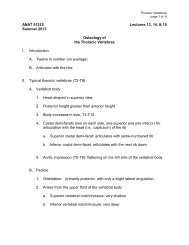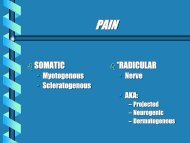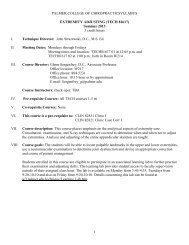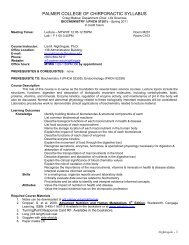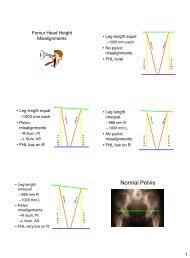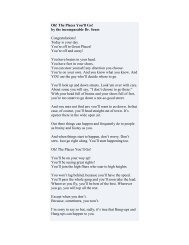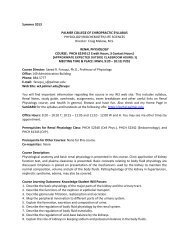Lab 5: The Integumentary System
Lab 5: The Integumentary System
Lab 5: The Integumentary System
Create successful ePaper yourself
Turn your PDF publications into a flip-book with our unique Google optimized e-Paper software.
<strong>Integumentary</strong> <strong>System</strong>page 1 of 5ANAT 11110 <strong>Lab</strong> 5Spring 2014<strong>The</strong> <strong>Integumentary</strong> <strong>System</strong><strong>The</strong> integumentary system is composed of the skin (aka, integument) and the‘accessory’ organs (i.e., hair, nails, glands, and cutaneous sensory receptors). In thislab, we will be studying the structure of the integumentary system.<strong>The</strong> skin consists of three layers: the epidermis, the dermis, and the subcutaneouslayer. <strong>The</strong> epidermis is composed of keratinized stratified squamous epithelium. It canbe divided into 5 zones, as follows (going from deepest to most superficial):- Stratum Basale: the lowest zone; a single layer of cuboidal or columnar cellsanchored to the underlying dermis by a basement membrane- Stratum Spinosum: several layers of cells, which may appear ‘spiny’ under themicroscope (the cell nuclei are still rather visible in this layer)- Stratum Granulosum: a few cell layers thick; cells appear speckled, havingnumerous granules of keratin in them- Stratum Lucidum: a thin clear layer, only present in the palms of the hands andthe soles of the feet (where the skin [and particularly the epidermis] is the thickest)- Stratum Corneum: the top-most layer of skin; 20-30 layers of flattened, deadkeratinized cells; this layer or parts of it may have pulled away from theunderlying part of the epidermis, during slide preparation<strong>The</strong> dermis lies directly underneath the epidermis. It is made up of connectivetissue. It can be divided up into two zones: the papillary layer and the reticular layer, asfollows:- Papillary layer: a narrow zone of loose connective tissue directly below thebasement membrane of the epidermis; inter-digitates with the epidermis to form‘papillae’- Reticular layer: a zone of dense irregular connective tissue below the papillarylayerBelow the dermis is the subcutaneous layer (aka, hypodermis). <strong>The</strong>subcutaneous layer is primarily composed of adipose tissue with some loose connectivetissue.Station 1: Structure of the SkinExamine a slide of thick skin. Begin your study by identifying the epidermis, themost superficial layer of the skin. Remember, the epidermis is composed ofkeratinized stratified squamous epithelium. Try to identify the 5 different layers
<strong>Integumentary</strong> <strong>System</strong>page 2 of 5of the epidermis: stratums basale, spinosum, granulosum, lucidum, andcorneum.Below the epidermis, you should see a thick layer of connective tissue; this isthe dermis. Immediately under the base of the epidermis, the appearance ofthe tissue might seem more open, with a lower concentration of fibers. This isthe papillary layer of the dermis. Below that, where the fibers become moreconcentrated, is the reticular layer of the dermis.Below the dermis, you will move into a zone of few fibers and many open,balloon-like cells. This is the subcutaneous layer, which is primarily composedof adipose tissue.In the space below, draw the over-all appearance of the skin, from epidermisthrough the subcutaneous layer.thick skin(use low power objective)Station 2: Structure of the Skin, cont.Now examine a slide of thin skin. Notice the difference between theappearance of the thin skin vs. the thick skin. Which layer is missing from theepidermis? ______________________________thin skin(use same objective lens as above)
<strong>Integumentary</strong> <strong>System</strong>page 3 of 5Station 3: Human Skin ColorHuman skin color comes from several sources. In the absence of any othercolorizing agents, human skin is pinkish in coloration, due to the presence ofoxygenated blood flowing through the dermis and subcutaneous layer of the skin.Human skin color also comes from the presence of two different pigments in the skin.Carotene is a yellow pigment, stored in the epidermis, dermis, and subcutaneous layer.<strong>The</strong> presence of carotene gives the skin a yellowish coloration. Having a very thickstratum corneum will also impart a yellowish coloration to the skin (this trait is mostlyrestricted to people of East Asian ancestry). Melanin is a brown/black pigment and isthe main agent of human skin coloration. <strong>The</strong> more melanin someone has in their skin,the darker their skin is. Melanin is found in the epidermis, manufactured by cells calledmelanocytes, found in the stratum basale.Observe the color of the skin on the palm of your hand. What color is it?_________________________________________Of the three coloring agents of human skin (subcutaneous blood flow, anextremely thick stratum corneum, melanin), which one(s) is(are) responsible forthis color? _________________________________________<strong>The</strong> skin on the palm of your hand and on the sole of your foot tends to bedevoid of melanin pigment, regardless of how dark the rest of your skin is.Examine the slide of 'thin skin, unpigmented’ (i.e., containing little or nomelanin). Look especially at the base of the epidermis. Now examine the slideof 'thin skin, pigmented' (i.e., containing significant amounts of melanin). Howdo they differ? ________________________________________________________________________________________________________________________________________________________________________________Station 4: Accessory Organs: HairHair is an accessory organ of the integumentary system. Hair is found all over thehuman body, except for a few places (e.g., palms of the hands, soles of the feet, partsof the external genitalia and nipples); most human hair is short and fine. A single hair ishoused in a tubular structure called the hair follicle, which extends down into the dermis,and even into the subcutaneous layer in some cases. <strong>The</strong> follicle is derived from theepidermis and has an outer covering of connective tissue. <strong>The</strong> hair itself consistsmainly of a column of tightly packed, flattened, dead keratinized epithelial cells. <strong>The</strong> haircan be divided into three parts. <strong>The</strong> hair bulb is the swollen, bulbous end of the hair,housed at the bottom of the follicle. <strong>The</strong> remaining column of hair within the follicle iscalled the hair root. That part of the hair external to the surface of the skin is the hairshaft.
<strong>Integumentary</strong> <strong>System</strong>page 4 of 5Examine the slide of human scalp. Does the skin here look like thin skin orthick skin? ________________________________ In this slide you should beable to see some examples of hair and hair follicles. Look to see if you can finda hair cut longitudinally. You should be able to make out the cut edge of thehair follicle; the inner, epithelial layer of the follicle should be visible (this will bethe layer with the noticeable cell nuclei; the cells of the hair proper will have nonuclei). Other hairs will have been sliced transversely and look like smalltargets. With these specimens, it is possible to see that the hair itself iscomposed of an inner core, called the medulla, surrounded by a (usually)pigmented cortex. Surrounding that in the slide will be a ring of epithelial cells(again, with visible nuclei), which is the hair follicle.In the space provided below, draw a hair and follicle that has been cutlongitudinally and one that has been cut transversely. (<strong>The</strong> longitudinal section,unless you're very lucky, probably was not cut down the center of the hair, soyou may not be able to see all of the hair, just part of it.)hair,longitudinalsectionhair,transversesectionStation 5: Accessory Organs: <strong>The</strong> Exocrine Glands<strong>The</strong>re are three types of exocrine glands housed in the skin. All three are housedpredominantly in the dermis, although all originate from epidermal tissue (and aretherefore, epithelial in nature). <strong>The</strong> sebaceous gland is an alveolar type of gland, andempties into the hair follicle. <strong>The</strong> apocrine gland also empties into the hair follicle, but istubular in shape. <strong>The</strong> eccrine gland is a tubular gland, which generally empties directlyonto the surface of the skin. <strong>The</strong> apocrine gland and the eccrine gland are collectivelycalled sudoriferous glands (aka, sweat glands).Examine a slide of human scalp. See if you can find any of these exocrineglands. Look down in the dermis for a cluster of similarly-sized, ring-likestructures. You're looking at the cut loops of a tubular gland (either an apocrinegland or an eccrine gland, again, collectively called sudoriferous glands). Finda hair follicle and look for a outgrowth extending downward from the side; the
<strong>Integumentary</strong> <strong>System</strong>page 5 of 5outgrowth may end in large flask-like or sac-like shapes (i.e., 'alveolar' inshape). This is a sebaceous gland.Below draw a few glands as seen in the slide.sebaceousexocrine glandsudoriferousexocrine gland



